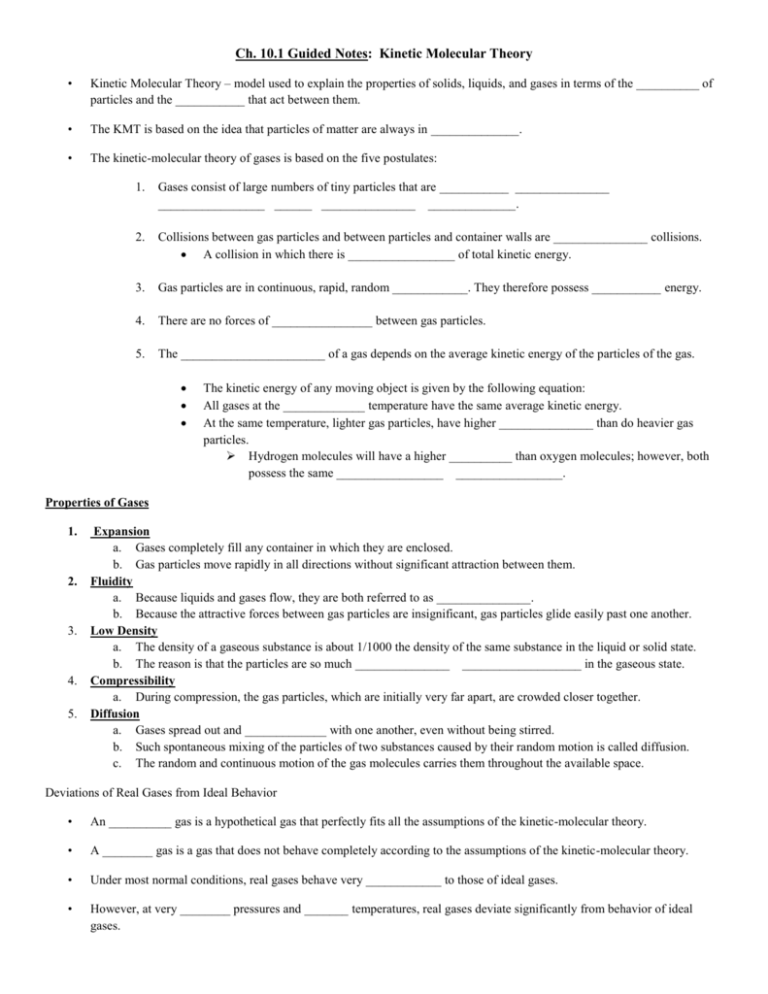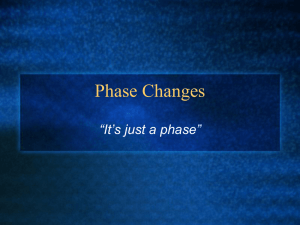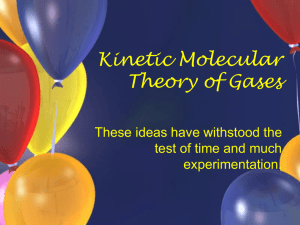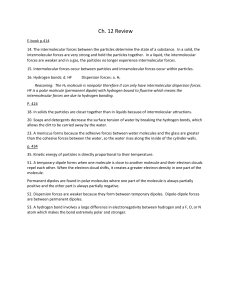Ch. 10: Kinetic Molecular Theory Notes
advertisement

Ch. 10.1 Guided Notes: Kinetic Molecular Theory • Kinetic Molecular Theory – model used to explain the properties of solids, liquids, and gases in terms of the __________ of particles and the ___________ that act between them. • The KMT is based on the idea that particles of matter are always in ______________. • The kinetic-molecular theory of gases is based on the five postulates: 1. Gases consist of large numbers of tiny particles that are ___________ _______________ _________________ ______ _______________ ______________. 2. Collisions between gas particles and between particles and container walls are _______________ collisions. A collision in which there is _________________ of total kinetic energy. 3. Gas particles are in continuous, rapid, random ____________. They therefore possess ___________ energy. 4. There are no forces of ________________ between gas particles. 5. The _______________________ of a gas depends on the average kinetic energy of the particles of the gas. The kinetic energy of any moving object is given by the following equation: All gases at the _____________ temperature have the same average kinetic energy. At the same temperature, lighter gas particles, have higher _______________ than do heavier gas particles. Hydrogen molecules will have a higher __________ than oxygen molecules; however, both possess the same _________________ _________________. Properties of Gases 1. 2. 3. 4. 5. Expansion a. Gases completely fill any container in which they are enclosed. b. Gas particles move rapidly in all directions without significant attraction between them. Fluidity a. Because liquids and gases flow, they are both referred to as _______________. b. Because the attractive forces between gas particles are insignificant, gas particles glide easily past one another. Low Density a. The density of a gaseous substance is about 1/1000 the density of the same substance in the liquid or solid state. b. The reason is that the particles are so much _______________ ___________________ in the gaseous state. Compressibility a. During compression, the gas particles, which are initially very far apart, are crowded closer together. Diffusion a. Gases spread out and _____________ with one another, even without being stirred. b. Such spontaneous mixing of the particles of two substances caused by their random motion is called diffusion. c. The random and continuous motion of the gas molecules carries them throughout the available space. Deviations of Real Gases from Ideal Behavior • An __________ gas is a hypothetical gas that perfectly fits all the assumptions of the kinetic-molecular theory. • A ________ gas is a gas that does not behave completely according to the assumptions of the kinetic-molecular theory. • Under most normal conditions, real gases behave very ____________ to those of ideal gases. • However, at very ________ pressures and _______ temperatures, real gases deviate significantly from behavior of ideal gases. Ch. 10.2 Guided Notes: Intermolecular Forces INTERMOLECULAR FORCES • Intermolecular forces are attractive forces ______________ molecules. – Become significant when particles are ____________________________. – Influence properties such as ____________________. – Intermolecular forces vary in strength but are generally ________________ than ionic and covalent bonds. Dipole-Dipole Forces • One type of intermolecular force exists between _____________ molecules. • Polar molecules are created when the polar bonds in a molecule are ______________ arranged. This creates partially ____________ and ______________ regions in the molecule. • Polar molecules are also called ________________. • The negative region in one polar molecule ______________ the positive region in adjacent molecules. • Such forces of attraction between polar molecules are known as ____________________ forces. Hydrogen Bonding • Hydrogen bonding – intermolecular force that exists between a hydrogen atom covalently bonded to a highly __________________ atom ( ) in one molecule and highly electronegative atom in another nearby molecule. • Hydrogen bonds are usually represented by __________ lines connecting the hydrogen-bonded hydrogen to the electronegative atom to which it is attracted. ( water for example) London Dispersion Forces • Even __________________ atoms and __________________ molecules can experience weak intermolecular attraction. • In any atom or molecule—polar or nonpolar—the electrons are in _____________________ motion. • As a result, at any instant the electron distribution may be _____________. A momentary uneven charge can create a _______________ pole at one end of an atom of molecule and a ______________ pole at the other. • This _______________ dipole can then induce a dipole in an adjacent atom or molecule. The two are held together for an instant by the _____________ attraction between temporary dipoles. • The intermolecular attractions resulting from the constant motion of electrons and the creation of instantaneous dipoles are called _________________________ forces. • London forces tend to ________________ with molar mass. • We can identify the types of intermolecular forces present in a substance by considering its __________________ and ______________________. • London dispersion forces are found in __________ substances. Strength of these attractions varies directly with _________________. • Dipole-dipole force and hydrogen bonds can also add to the force of attraction. ____________________ is the strongest of the intermolecular forces. What Do You Think? • In each of the following select the substance with the higher boiling point. Justify your answer. (a) CH4 or CCl4 (b) NH3 or PH3 Ch. 10.3 Guided Notes: Properties of Liquids and the Kinetic-Molecular Theory • A liquid can be described as a form of matter that has a definite ________________ and takes the shape of its container. • The attractive forces between particles in a liquid are more effective than those between particles in a gas. • The particles in a liquid are not bound together in fixed positions. Instead, they move about constantly. • Liquids, like gases, are fluids because they can flow and therefore take the ___________ of its container. Common Properties of Liquids Include: 1. Relatively High Density • At normal atmospheric pressure, most substances are hundreds of times denser in the liquid state than in the gaseous state. 2. Relative Incompressibility • Liquids are much _____________ compressible than gases because liquid particles are more closely packed together. 3. Ability to Diffuse • Any liquid gradually diffuses throughout liquid in which it can dissolve. 4. Viscosity – measure of a liquid’s resistance to flow: – Liquids with stronger intermolecular forces tend to be highly viscous. The greater the viscosity, the more ________________ it flows. Viscosity is temperature dependent. 5. Cohesion and Adhesion – Cohesive forces – intermolecular forces among the molecules of the liquid – Adhesive forces – forces between the liquid molecules and their _______________. – This process is responsible for the meniscus that forms in a test tube or graduated cylinder. 6. Surface Tension • Force that tends to pull adjacent parts of a liquid’s surface together, thereby decreasing surface area to the smallest possible size. • Molecules at the surface of a liquid experience an unbalanced attraction. This gives the surface a skinlike property. • Surface tension causes liquid droplets to take a spherical shape. • The higher the force of attraction between the particles of a liquid, the higher the surface tension. • Water has a very high surface tension. What property does water have that would give it such a strong surface tension? • Surface tension causes liquid droplets to take a spherical shape. • Surface tension prevents objects from breaking through the surface Ch. 10.4 Guided Notes: Solids and Phase Changes Solids • The particles of a solid are more _____________________ than those of a liquid or gas. • Intermolecular forces between particles are __________________ in solids compared to liquids. • Attractive forces tend to hold the particles of a solid in relatively ____________ positions. (_____________ movement around fixed points) • Properties common to solids include: _________________________________________________________________ ________________________________________________________________________________________________. Changes in State • A _______________ change is the reversible _____________ change that occurs when a substance changes from one state of matter to another. Phase Changes: Heating Curves • graph that illustrates the changes of state as a substance is heated. • As heat is added to a solid, its temperature _________________. • A point is reached where the temperature ________________ as heat is added. • This is the point at which the solid changes to a liquid. (______________ Point) • Energy from the heat is used to _________________ the attractive forces between the particles. Heating Curve for Water • While a substance changes a state, its temperature does not _____________ until the change of state is complete. • Once the phase change is complete, the ________________ will begin to increase as heat is added. • This continues until the liquid reaches its _______________ point. • As the liquid changes to a gas, the temperature ____________ until the phase change is complete. (__________ point) The heat of fusion (Hfus) • is the amount of heat needed to melt _______________ of a solid at its melting point. • is the amount of heat released when 1 gram of liquid ______________ at its freezing point. • for water at 0°C Hfus is ________________. • The quantity of heat that is absorbed during melting or released during freezing can be found using the equation: Note- The Heat of Fusion equation is used only at the melting/freezing transition, where the temperature remains the same. • Example Problem: How much heat is needed to melt 15.0 g of ice at 0°C? The heat of vaporization (Hvap) is the amount of heat • ___________ to vaporize ________ of a liquid to gas at the boiling point. • ___________ when 1 g of a gas ___________ to liquid at the boiling point. • for water at 100°C Hvap is ________________ J/g. • The quantity of heat that is absorbed during melting or released during freezing can be found using the equation: • Example Problem: Calculate the amount of heat needed to convert 190.0 g of liquid water to steam at 100ºC. Ch. 10.5 Guided Notes: Phase Diagrams • A phase diagram is a graph of pressure versus temperature that shows the conditions under which the phases of a substance exist. • The triple point of a substance indicates the temperature and pressure conditions at which the solid, liquid, and vapor of the substance can ___________________________ at equilibrium. • Notice the phase boundary between liquid and gas does not continue indefinitely. Instead, it terminates at a point called the critical point. • This reflects the fact that, at extremely high temperatures and pressures, the liquid and gaseous phases become indistinguishable, in what is known as a ___________________________ _______________________. Phase Diagram for Carbon Dioxide • The critical temperature (tc) is the temperature above which the substance cannot exist in the liquid state. • The critical pressure (Pc ) is the lowest pressure at which the substance can exist as a _____________________ at the critical temperature.








